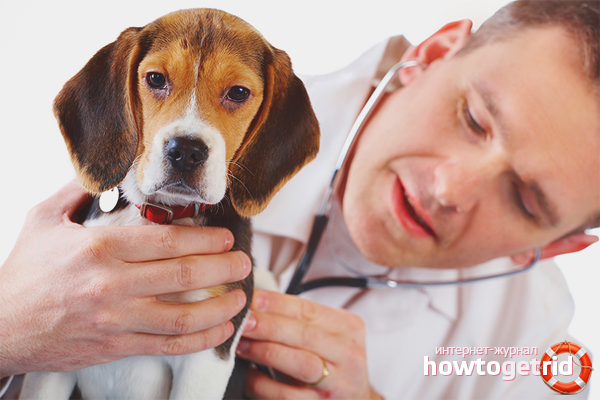The content of the article
Often, those who first start a dog at home do not know all the subtleties and nuances of its feeding, care and upbringing. But this is not difficult - if you have a desire, you can easily learn all the skills. After all, even young parents often after the birth of a child do not know how to change their diapers, how to feed and change clothes. Over time, knowledge and experience becomes more and more, and after a few years the experienced mother herself is able to give answers to questions about the health and upbringing of the child.
A dog can be compared to a newborn baby who has appeared in your family. She also cannot tell you about what is bothering her or about where she hurts. And your task, as a sensitive owner and faithful friend, is to recognize in time that some changes are taking place in the animal's body. We will present some symptoms that may indicate that the dog is sick.
Behavior
The first thing that occurs during any disease is discomfort and pain in various situations. Therefore, the dog’s behavior during illness changes.
- Often during illness, the dog becomes lethargic, sleepy, and lethargic. She is no longer interested in games that she has always been glad of. The dog clogs into the far and dark corner so that no one touches it. Pets prefer to survive the disease alone.
- Another sign of the disease is a lack of appetite. It happens that a dog refuses food if you overfeed him or he spends little time in the fresh air. If these causes are excluded, then poor appetite may be due to malaise.
- Sometimes a dog can become aggressive even with those he has known for more than one year. This happens when a sick animal is squeezed, forced to play. Treat your pet with understanding, do you lead an active lifestyle when you are ill?
- Sometimes a dog may not eat, but he drinks a lot. This indicates food poisoning, an infectious disease (if the temperature rises and the body sweats). High fluid intake can be a symptom of diabetes.
- Sometimes a dog may be tormented by vomiting and severe shortness of breath. In this case, consult a veterinarian.
- Constipation or diarrhea (especially with blood) is also a good reason to urgently take a friend to the doctor.
- The normal body temperature of the dog is 38.5-39 degrees. If it is significantly higher or lower, you need to consult a specialist. High temperature indicates an infectious disease or inflammatory process in the body. Low body temperature is very dangerous, and most often indicates intoxication or internal bleeding.
It is very important to carefully monitor the pet in order to recognize the disease as soon as possible. Early diagnosis of the disease provides a more productive and effective treatment.
Appearance
If the dog is sick for a long time, or painful symptoms are sluggish, after a while the pet's appearance may change.
- The coat of a healthy dog is usually shiny and smooth. If the pet receives an insufficient amount of vitamins and minerals (due to poor appetite or lack of absorption), then the coat becomes dull and faded.
- Due to malnutrition and refusal to eat, the dog is rapidly losing weight.
- If inflammatory processes occur in the body (especially with an increase in temperature), the nose stays hot and dry all the time.
- Sometimes the movements may be inaccurate, spontaneous jerking of certain muscle groups appear.
- Unusual discharge may appear from the nose, ears, eyes and mouth.
- An unpleasant smell often emanates from the jaws of a sick dog.
- When a pet is sick, his salivation increases.
- It so happens that the ears, chest, upper and lower eyelids of the dog swell, make the pet's face puffy. Most often, this indicates an allergic reaction.
- Sometimes a dog may have bleeding - from the nose, mouth, ears, anus. Such symptoms indicate the urgent need to transport the pet to a veterinary clinic.
- Sometimes it happens that a dog’s abdominal size increases dramatically. Most often, this indicates a torsion of the stomach. This occurs due to the twisting of the spleen around the esophagus. In this case, the passage of food is impaired. With this diagnosis, the dog becomes restless, then lies down, then stands up, howls. This requires immediate medical attention.
- If a dog has photophobia, it hurts to swallow, it becomes aggressive and there are signs of paralysis - rabies on the face.
Any deviation from the dog’s usual behavior should alert you. In order not to miss the disease, you need to examine your pet more often - wool, mouth, ears, etc.
What to do if a pet is sick
If the dog is simply sluggish and refuses to eat, do not rush to take it to the doctor. This may be a sign of improper feeding, mild poisoning, or simply a longing for a friend. In this case, you need to show maximum care and love.
If you suspect a pet’s ailments, you need to follow it for a while - measure the body temperature in the morning and evening, provide warmth and gentle treatment, give your favorite treats, and feed with light food. If the ailment persists, consult a doctor.
Also, the veterinarian should be consulted as soon as possible if repeated vomiting, blood in the stool or vomit appears, if the dog whines with pain or behaves unnaturally. The doctor should be consulted if any suspicion of behavior and appearance arose in relation to the puppy.
Usually, an experienced dog breeder and an attentive owner do not have questions about how to recognize a pet's disease. Treat your dog like a friend with warmth and care. And then you yourself will understand if something is wrong with the animal. Be attentive to your pet, because he can only rely on you.
Video: how to understand that a dog is sick











Submit